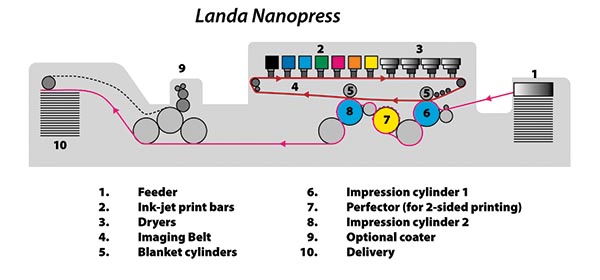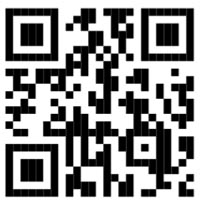
(This article originally appeared in the May 31 edition of the drupa daily.)
The Landa Digital Print (Hall 9/A33-1–A33–9) tagline for drupa 2024 is “Run More,” and they are supporting that with the introduction of new “faster and smarter” presses. The S11 simplex and S11P duplex B1 presses support a maximum sheet size of 29.5 x 41.3 in., with a maximum print area of 29.0 x 40.6 in. The presses run a wide range of media thickness from 1.6-pt. to 32-pt. (40–800 microns). Unlike the majority of inkjet presses, the Landa technology advantage is that it can run a wide variety of media, including paper, plastics, and more.
The new optional 11K module elevates productivity from 6,500 sheets per hour (sph) to 11,200 sph. The new IR ink drying system enables transfer of ink from the heated blanket to the media at the higher speed of 11,200 sph, delivering a completely dry sheet ready for finishing.
The S11P duplex carries the same overall specs as the S11, and can duplex at half the throughput. The new Landa optional PrintAI module enhances print quality with TrueText, enabling the printing of very sharp fine lines and microtext for the most demanding pharma, packaging, and brand protection applications. The PrintAI module also adds AI to the standard AQM (Active Quality Management), further raising the bar on quality, predictability, and operational performance.

Like most software, the Landa Press software can be updated, and the company says they are now upgrading the presses every month, so customers don’t have to wait very long to have any issues addressed. That includes updating Landa’s Active Quality Management (AQM), an inline, closed-loop quality control system with automatic correction for registration, nozzle failures, etc.
Landa NanoInk contains ultra-small pigment particles in that are tens of nanometers in size. In comparison, good quality offset inks have a particle size of approximately 500 nm—at least 10 times larger. The unique qualities and advantages of Landa NanoInk provide ink pigments, that when reduced to narrow distributions in the nanometric scale become unusually powerful colorants.
The Landa presses configured with four colors (CMYK) achieve a gamut of about 84% of the Pantone range. It can be configured with seven colors (CMYKOGB) which achieves about 96% of the Pantone range. The Nanographic prints are fully recyclable due to being water-based and the very low ink laydown of the Nanography process. Since one of the areas of focus for the technology is packaging, Landa made sure the inks meet FDA and EU regulations for food contact (indirect), and the BRC/IOP Global Standard for Packaging and Packaging Materials, amongst others.
 Nano. A Love Story. is a full-scale theatre production running throughout drupa in the Landa Theater, located in Hall 7. Use this QR code to reserve your seat. Nano. A Love Story. ist eine groß angelegte Inszenierung, die während der gesamten drupa im Landa Theater in Halle 7 läuft. Über diesen QR-Code können Sie Ihren Platz reservieren.
Nano. A Love Story. is a full-scale theatre production running throughout drupa in the Landa Theater, located in Hall 7. Use this QR code to reserve your seat. Nano. A Love Story. ist eine groß angelegte Inszenierung, die während der gesamten drupa im Landa Theater in Halle 7 läuft. Über diesen QR-Code können Sie Ihren Platz reservieren.
Landa zeigt B1-Digitaldruckmaschine mit Offset-Kapazität
Das Motto von Landa Digital Print (Halle 9/A33-1-A33-9) für die drupa 2024 lautet „Run More“ (frei übersetzt: „mehr produzieren“) – was das Unternehmen auch mit dem Launch seiner neuen, „schnelleren und intelligenten“ Druckmaschinen unterstützt. Die S11-Simplex- und S11P-Duplex-B1-Druckmaschinen unterstützen ein maximales Bogenformat von 750 x 1050 mm mit einem maximalen Druckbereich von 736 x 1036 mm. Die Druckmaschinen verarbeiten eine große Bandbreite an Materialstärken von 1,6 bis 32 pt (40-800 Mikrometer). Im Gegensatz zu den meisten Inkjetdrucksystemen liegt der Vorteil der Landa-Technologie darin, dass sie eine Vielzahl von Medien verarbeiten kann, einschließlich Papier, Kunststoff und mehr.
Das neue optionale 11K-Modul steigert die Produktivität von 6.500 auf 11.200 Bogen pro Stunde. Das neue IR-Trocknungssystem ermöglicht die Übertragung der Farbe vom beheizten Drucktuch auf das Material bei der höheren Geschwindigkeit von 11.200 Bogen pro Stunde und liefert einen vollständig trockenen Bogen, der für die Weiterverarbeitung bereit ist.
Die S11P verfügt über die gleichen technischen Daten wie die S11 und kann bei halbem Durchsatz doppelseitig drucken. Das neue optionale PrintAI-Modul von Landa verbessert die Druckqualität und ermöglicht den Druck von sehr scharfen, feinen Linien und Mikrotext für die anspruchsvollsten Anwendungen in den Bereichen Pharma, Verpackung und Markenschutz. Das PrintAI-Modul ergänzt das standardmäßige AQM (Active Quality Management) um künstliche Intelligenz und legt damit die Messlatte für Qualität, Vorhersagbarkeit und Betriebsleistung noch höher.
Wie die meisten Softwarelösungen kann auch die Landa Press Software aktualisiert werden. Das Unternehmen sagt, dass es die Druckmaschinen jetzt jeden Monat aktualisiert, so dass die Kunden nicht lange warten müssen, bis alle Probleme behoben sind. Dazu gehört auch die Aktualisierung von Landa's Active Quality Management (AQM), einem Inline-Qualitätskontrollsystem mit automatischer Korrektur von Registerfehlern oder Düsen-Ausfällen, usw.
Landa NanoInk enthält ultrakleine Pigmentpartikel, die nur wenige Nanometer groß sind. Im Vergleich dazu besitzen hochwertige Offsetdruckfarben eine Partikelgröße von etwa 500 nm – also mindestens zehnmal größer. Die einzigartigen Eigenschaften und Vorteile von Landa NanoInk sorgen dafür, dass die Pigmente der Druckfarbe, die auf eine enge Verteilung im Nanometerbereich reduziert werden, zu ungewöhnlich leistungsstarken Farbstoffen werden.
Die Landa-Druckmaschinen, die mit vier Farben (CMYK) konfiguriert sind, erreichen einen Farbumfang von etwa 84 % der Pantone-Palette. Sie können mit sieben Farben (CMYKOGB) konfiguriert werden, wodurch sich etwa 96 % des Pantone-Farbraums abdecken lassen. Die nanographischen Drucke sind, weil sie auf Wasserbasis hergestellt werden und das Nanographie-Verfahren eine sehr geringe Farbabgabe aufweist, vollständig recycelbar. Da einer der Schwerpunkte der Technologie die Verpackung ist, hat Landa dafür gesorgt, dass die Druckfarben unter anderem die FDA- und EU-Vorschriften für den indirekten Kontakt mit Lebensmitteln sowie den BRC/IOP-Global-Standard für Verpackungen und Verpackungsmaterialien erfüllen.














